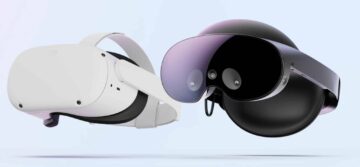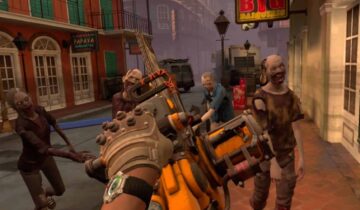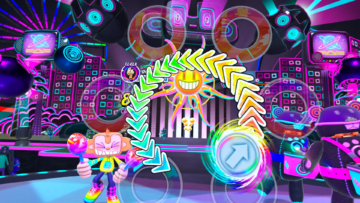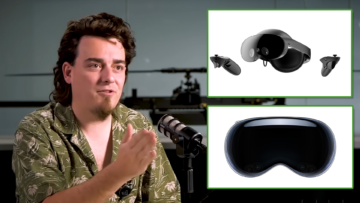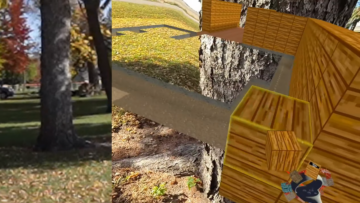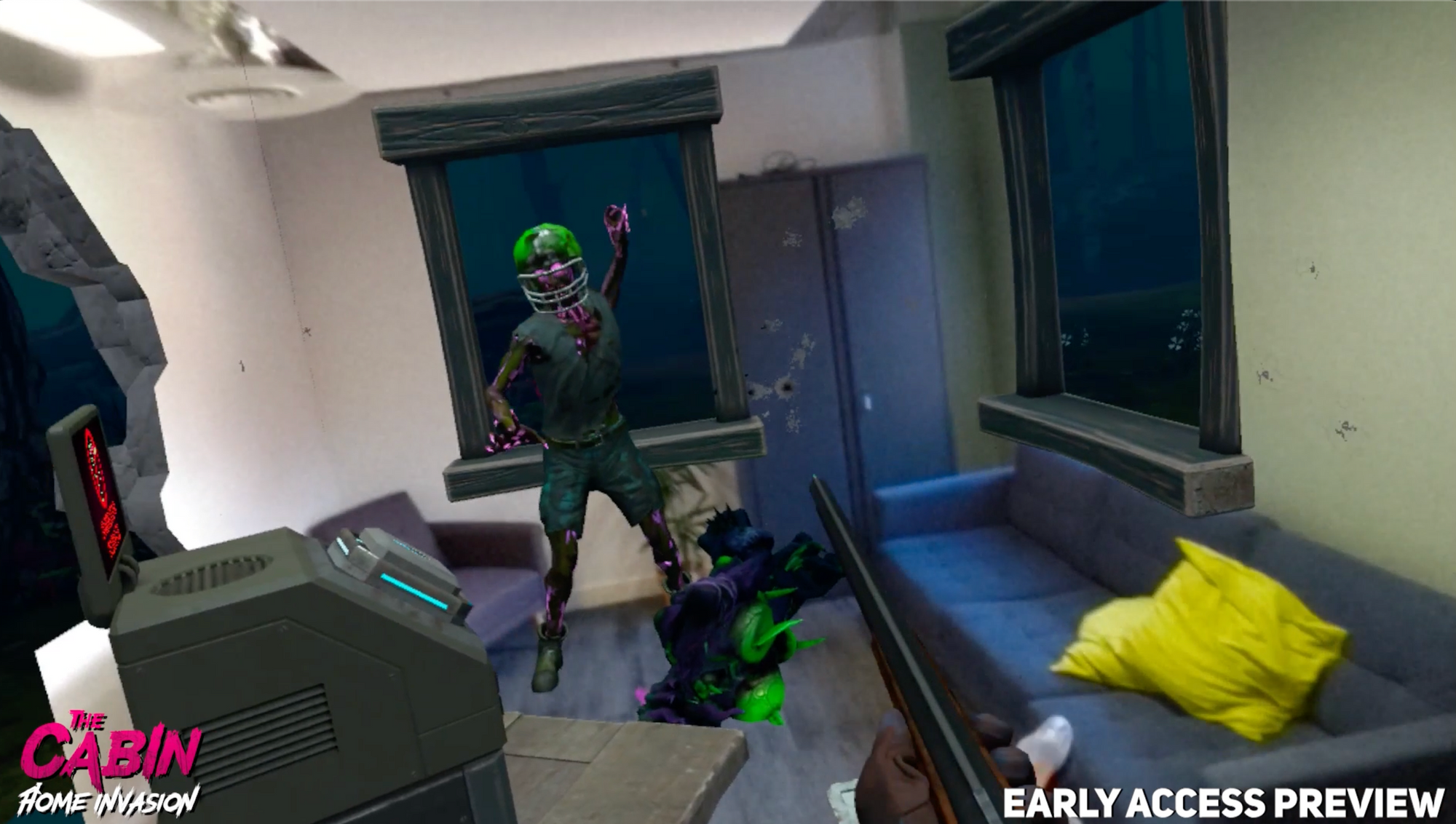
For the second year in a row, I’ve come away from Gamescom excited to play more of Drop Dead: The Cabin – except this time, in mixed reality.
In 2022, Soul Assembly’s Gamescom demo of Drop Dead: The Cabin was one of our favorites of the show. Unfortunately, the game launched a few months later to a rocky start: not only did some of its spotlight get stolen by the release of PSVR 2 in the same week, but there were player reports of bugs and other issues that hampered the experience.
A year on, Soul Assembly was back at Gamescom 2023 with a new update to showcase. The team says they’ve not only been addressing issues that players experienced at launch with the main game, but also working on a new update that might ultimately grant the title a second chance.
This new update for The Cabin will pull focus towards the mixed reality features that Meta is pushing alongside its Quest 3 headset, set to debut this fall. A new mixed reality game mode titled Home Invasion will launch in October as a free update for The Cabin. It’s clear the Soul Assembly are hoping that the new mode might put the wider experience up for reappraisal with players.
Inverting The Cabin
For new Quest 3 owners later this year, Home Invasion looks like one of only a few mixed reality experiences that actually put your entire play space to use, becoming a dynamic and integral part of the experience. While other experiences like Cubism or Demeo will bring a game board or a puzzle into your room, The Cabin’s Home Invasion wants to take that one step further, transforming your environment into a battleground.
First teased in a video from Meta CEO Mark Zuckerberg showcasing the potential of mixed reality on Quest 3, Home Invasion inverts the premise of the original release: instead of slowly venturing out of the cabin to fight zombies and defend equipment, the zombies will come to you, invading your play space and forcing you to defend from within.
Zombies will arrive through virtual windows and doors, as well as giant virtual holes that they will smash open in later waves. You’ll use a familiar selection of guns and melee weapons to stave them off, defending the real-life room that you’re playing in.
Our demo at Gamescom used Quest Pro and took place in a fairly small area, with the room’s real door converted into a virtual one in the style of Drop Dead, while a virtual window was positioned up on an adjacent wall. These virtual set pieces give you a glimpse out into the virtual forest from which zombies will emerge and stumble towards you, eventually leaping inside to attack you.
There’s also a transmitter device in the room, which features a minigame that will get the satellite – visible outside through the virtual windows – up and running. This begins a 10-minute countdown to extraction, but if the zombies attack the satellite, you’ll need to complete the minigame again to resume the timer.
Unlike the co-op-focused main mode, Home Invasion is a single player experience. At first glance, the mode feels more like an amusing arcade mixed reality experience that you could easily demo to friends and family as opposed to a challenge equivalent to the main offering.
With the advent of Quest 3’s full reveal later this month – and its launch following after – we’ve yet to see proof of any mixed reality experiences that truly sell the feature as a must-have. Home Invasion will no doubt prove entertaining, equivalent to Resolution Games’ Spatial Ops in its commitment to integrating with a physical space to create a new category of experience. That said, it hardly makes the case for a headset upgrade or new purchase on the basis of mixed reality. Granted, it’s clearly not meant to, but it’s nonetheless interesting to note as we get closer to Connect. We’re still looking for the headset-selling mixed reality experience.
That said, it’s also hard to see Home Invasion flourishing beyond hey-look-at-what-my-new-headset-can-do status. Anyone who wants something more in-depth and challenging will probably end up playing the standard virtual reality mode. Even though the aforementioned Spatial Ops experience came with its quirks (mainly relating to the room and play area setup), it also presented a concept that will only truly be valuable in mixed reality. Taking the mechanics of The Cabin and playing with them in mixed reality will be entertaining, but hardly essential. The clear advantage that it has over the former experience is that it’s single player and can adapt to any room large or small – Spatial Ops only truly shines with the tall order of multiple players present in one giant, empty play space.
A Few Caveats
There are some other caveats to consider with Home Invasion, too. While it’s fantastic to see a virtual window placed on a real wall, you will find yourself trying to extend your arm through the window, to give your weapon a better angle on an approaching zombie. The result? A hand that goes smashing into a real wall, instead of passing through the virtual opening that you see in-headset.
The Soul Assembly team understandably waved this off as proof of immersion, which it is – but at the same time, it also breaks immersion in its reminder of the limitations posed by the technology. Perhaps punching holes in drywall will become the mixed reality equivalent of the roomscale VR users who broke TVs jumping off Ritchie’s Plank?
That said, this might not be as much of a problem in a less-confined space. Our demo took place in a fairly small room, not giving much room to move or place multiple windows and doors. It would be interesting to see the mode in an expansive living room with more furniture and areas to move around. Soul Assembly even told me that if your sofa is marked out, zombies will interact with it and even stand on top of it. Personally, I’d love to see them take a seat.
On Quest Pro, the virtual elements, such as the Drop Dead door and window, are positioned around the room manually by the users before starting, given that the headset doesn’t have automatic room setup and detection. Quest 3 will seemingly be able to more intelligently understand a play space using its depth sensor. It’s likely that Home Invasion might be able to more seamlessly generate a mixed reality battleground on Quest 3 automatically, but Soul Assembly understandably played coy with those details at Gamescom.
The demo we played also wasn’t free of bugs. Soul Assembly wanted to stress that the Gamescom demo was an early pre-release build, which will be refined and tweaked prior to launch. That said, there was a known issue with weapon spawn positions during my demo, and a surprise issue in my colleague Henry’s where zombies stopped spawning mid-round. Again, these might get fixed before October, but nonetheless felt worth mentioning given the buggy initial launch of the base game in February.
Home Invasion will be available in October on all supported Quest headsets (including Quest 2, but only with its black-and-white passthrough), included as a free update for The Cabin and accessible from within the existing game.
- SEO Powered Content & PR Distribution. Get Amplified Today.
- PlatoData.Network Vertical Generative Ai. Empower Yourself. Access Here.
- PlatoAiStream. Web3 Intelligence. Knowledge Amplified. Access Here.
- PlatoESG. Automotive / EVs, Carbon, CleanTech, Energy, Environment, Solar, Waste Management. Access Here.
- PlatoHealth. Biotech and Clinical Trials Intelligence. Access Here.
- ChartPrime. Elevate your Trading Game with ChartPrime. Access Here.
- BlockOffsets. Modernizing Environmental Offset Ownership. Access Here.
- Source: https://www.uploadvr.com/the-cabin-home-invasion-preview/
- :has
- :is
- :not
- :where
- $UP
- 2022
- 2023
- a
- Able
- accessible
- actually
- adapt
- addressing
- adjacent
- ADvantage
- advent
- After
- again
- All
- alongside
- also
- an
- and
- any
- anyone
- approaching
- Arcade
- ARE
- AREA
- areas
- ARM
- around
- AS
- Assembly
- At
- attack
- Automatic
- automatically
- available
- away
- back
- base
- basis
- battleground
- BE
- become
- becoming
- been
- before
- Better
- Beyond
- board
- breaks
- bring
- Broke
- bugs
- build
- but
- by
- came
- CAN
- case
- Category
- ceo
- challenge
- challenging
- Chance
- clear
- clearly
- closer
- colleague
- come
- commitment
- complete
- concept
- Connect
- Consider
- converted
- could
- countdown
- create
- dead
- debut
- Defending
- Demo
- depth
- details
- Detection
- device
- DID
- doesn
- Door
- doors
- doubt
- Drop
- Drop Dead
- drop dead: the cabin
- during
- dynamic
- Early
- easily
- elements
- emerge
- end
- entertaining
- Entire
- Environment
- equipment
- Equivalent
- essential
- Even
- eventually
- Except
- excited
- existing
- expansive
- experience
- experienced
- Experiences
- extend
- extraction
- fairly
- Fall
- familiar
- family
- fantastic
- Favorites
- Feature
- Features
- February
- few
- fight
- Find
- First
- fixed
- Focus
- following
- For
- forest
- Former
- Free
- friends
- from
- full
- further
- game
- gameplay
- Games
- Gamescom
- generate
- get
- giant
- Give
- given
- Giving
- Glance
- Glimpse
- Goes
- grant
- granted
- GUNS
- hand
- Hard
- Have
- Headset
- headsets
- henry
- Holes
- Home
- hoping
- HTTPS
- i
- if
- immersion
- in
- in-depth
- included
- Including
- initial
- inside
- instead
- integral
- Integrating
- interact
- interesting
- into
- invasion
- issue
- issues
- IT
- ITS
- known
- large
- later
- launch
- launched
- like
- likely
- limitations
- living
- ll
- looking
- LOOKS
- love
- Main
- mainly
- MAKES
- manually
- mark
- marked
- me
- meant
- mechanics
- Meta
- might
- mixed
- mixed reality
- Mode
- Month
- months
- more
- move
- much
- multiple
- Must-Have
- my
- Need
- New
- no
- note
- october
- of
- off
- offer
- offering
- on
- ONE
- only
- open
- opening
- opposed
- or
- order
- original
- Other
- our
- out
- outside
- over
- owners
- part
- Passing
- passthrough
- perhaps
- Personally
- physical
- pieces
- Place
- plato
- Plato Data Intelligence
- PlatoData
- Play
- played
- player
- players
- playing
- posed
- positioned
- positions
- potential
- present
- presented
- Prior
- Pro
- probably
- Problem
- proof
- Prove
- provided
- PSVR
- PSVR 2
- purchase
- Pushing
- put
- puzzle
- quest
- quest 2
- quest 3
- quest pro
- RE
- real
- Reality
- Reality experience
- refined
- release
- Reports
- Resolution
- resolution games
- result
- resume
- reveal
- rocky
- Room
- ROW
- running
- s
- Said
- same
- satellite
- says
- seamlessly
- Second
- see
- seemingly
- selection
- sell
- set
- setup
- shines
- show
- showcase
- showcasing
- single
- Slowly
- small
- Smash
- Snippet
- some
- something
- Soul
- soul assembly
- Space
- Spatial
- spatial ops
- Spawn
- Spotlight
- stand
- standard
- start
- Starting
- Status
- Step
- Still
- stolen
- stopped
- stress
- style
- such
- Supported
- surprise
- T
- Take
- taking
- team
- teased
- Technology
- that
- The
- the cabin
- Them
- There.
- These
- they
- this
- this year
- those
- though?
- Through
- time
- Title
- titled
- to
- too
- took
- top
- towards
- transforming
- truly
- Ultimately
- understand
- Understandably
- unfortunately
- Update
- upgrade
- UploadVR
- use
- used
- users
- using
- Valuable
- Ve
- Virtual
- Virtual reality
- visible
- vr
- vr users
- Wall
- wanted
- wants
- was
- wasn
- waves
- we
- Weapons
- week
- WELL
- were
- which
- while
- WHO
- wider
- will
- window
- windows
- with
- within
- working
- worth
- would
- year
- yet
- you
- Your
- yourself
- zephyrnet
- zombie

